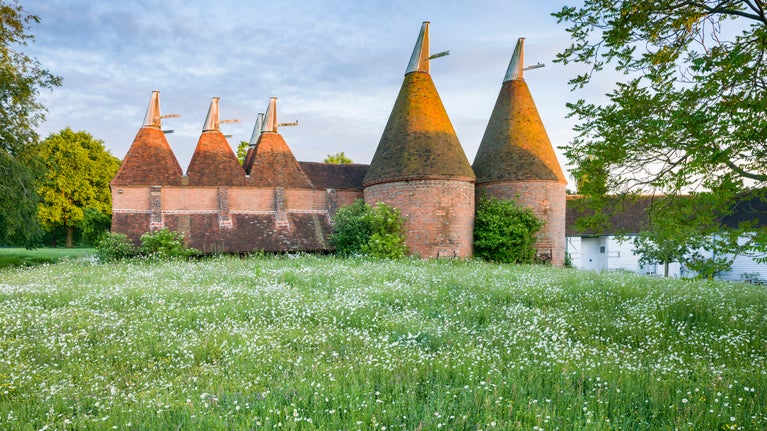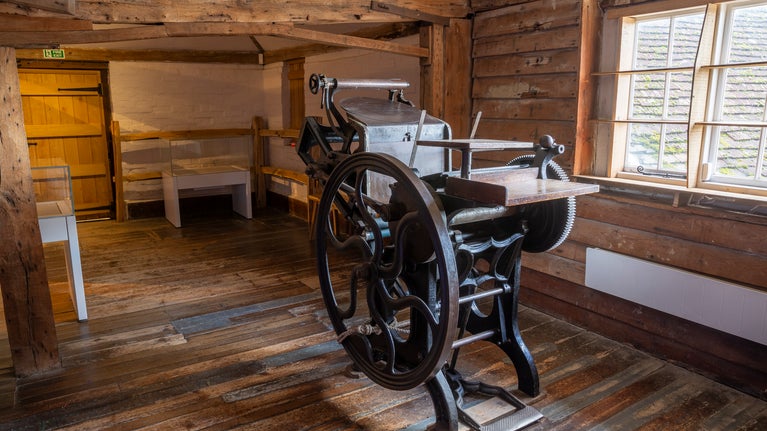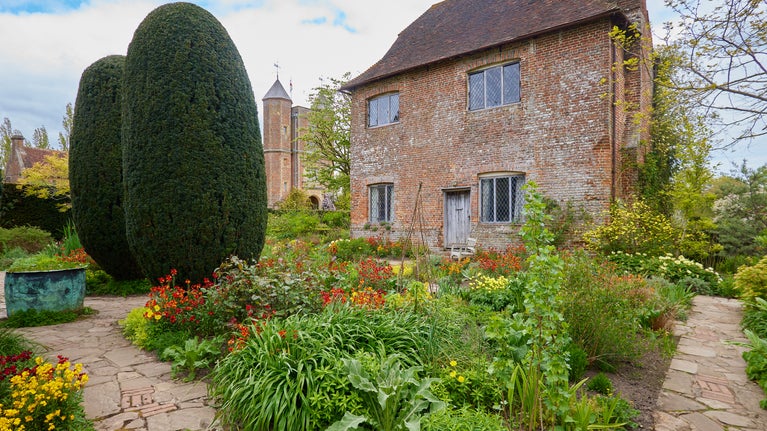Exploring the buildings at Sissinghurst Castle Garden

Jump to
Visit the Tower and Library, some of the few remaining buildings at Sissinghurst Castle Garden that Vita Sackville-West and Harold Nicolson lived and worked in. Explore their writing retreats, entertaining spaces and viewpoints from which they designed and renovated the garden surrounding them.
The Tower
Climbing the 78 steps to the top of the Tower is a remarkable way to start a visit. From the parapets the structure of Vita and Harold’s garden, with its distinctive rooms, is visible and there is a hint of the full scale of Sissinghurst’s Elizabethan manor house.
Vita's Writing Room
Complex conservation work on Vita's Writing Room was completed in February 2023 and visitors could once again view the magnificent and historical space from the Tower stairwell.
You can watch footage of the restoration on the BBC's Hidden Treasures of the National Trust here.
Vita’s Writing Room offers a glimpse of her internal intellectual life. Almost 4,000 books line the walls, arranged by theme from astronomy to Renaissance poetry to 1930s gender theory and on to practical gardening advice.
Vita worked at her heavy oak desk, which has remained almost unchanged since she left it in 1962, complete with a large Mexican bowl full of soil samples, ballpoint pens, a chewed cigarette holder and a pocket calendar with photographs of Alsatian dogs.
The Writing Room is a fragile time capsule of a life with even the carpet original to Vita’s time.

Must-sees in the Tower, from Regional Curator Dr Jerzy J Kierkuc-Bielinski:
A hidden treasure The mysterious case of the Gladstone bag. All good castles should have a story about a hidden treasure, locked away in a tower out of sight until one day it is discovered by chance. One of the most fascinating objects is a rather old and battered leather case. It was found locked in a corner of the turret room in the Tower.
Naked Boy on a Tiger In 2019 we undertook conservation on this painting – a work showing a naked child seated on the back of a tiger and found out that this painting was something rather special. It was, in fact, a very early copy based on a detail of one of the most important works of art ever painted in Britain – Sir Peter Paul Rubens' 1636 ceiling of the Banqueting House, Whitehall, London.

The Big Room (Library)
Completed in spring 1935, the library had once been a stables and saddle room, and Vita and Harold nicknamed it ‘The Big Room’. It was used to house almost 4,000 books and as a drawing room for entertaining guests, including the writer Virginia Woolf, politician Sir Winston Churchill and artist Rex Whistler.
Vita and Harold transformed the room by adding a large window, building a stone fireplace using fragments of the Elizabethan ruin found in the garden, and panelling the walls in dark oak. You can see echoes of Vita’s grand childhood home at Knole everywhere.
Must-sees in the Library, from Regional Curator Dr Jerzy J Kierkuc-Bielinski:
Sir John Lavery’s Portrait of Violet Keppel, Mrs Denys Trefusis The liveliness of this portrait is captivating and made me want to know more about the life of the woman in the painting.
The painted cupboard Vita and Harold married in 1913. Their wedding presents reflected their wealthy social circle and this painted cupboard, thought to be made in Italy around 1750, was a gift from Sir Louis Mallet who Harold worked with as a diplomat in Istanbul.
Portrait of Thomas Sackville, 1st Earl of Dorset This imposing painting shows Vita’s ancestor who married Cecily Baker of Sissinghurst in the 16th century. In April 1930 Harold wrote to Vita after seeing Sissinghurst for the first time and he was convinced they should buy it as there was a family connection for her. The oil painting was bought by Vita and Harold’s art historian son, Benedict, to be displayed at Sissinghurst.
French prisoners of war at Sissinghurst Castle During the global conflict of the Seven Years War (1756–1763) as many as 3,000 French men were imprisoned in appalling conditions at what they nicknamed ‘Sissinghurst Castle’. An ink and dye painting reveals how the buildings looked in about 1760, and the brutal treatment of the prisoners.
Regional curator’s must-see: Philip de László’s portrait of Vita in 1910 This image of Vita is especially stylish. It was painted when she was aged 18 to mark her ‘coming out’ into society as a young woman. Vita’s mother specifically chose de László as he was the society painter at the time.

The Oast Exhibition Space
Oast Houses are a common sight in Kent and were traditionally used to dry hops which were then sent off to a brewer or hop merchant. While the six square oasts were most likely built in the 18th century, the two larger square roundels were added in the 19th century.
Today, the building performs multiple functions, from storage rooms and workshop areas, to a lecture hall and an exhibition space.
The upstairs area may be closed during select periods of the year to allow for the space to be changed, cleaned, or used for events.

The Minerva Printing Press
Frequent visitors may recognise the printing press on display in the Oast Exhibition Space (pictured below). It is a ‘Minerva’ platen hand-set printing press, known as the ‘Hogarth Press’, and made of cast iron with steel and wood, built c. 1915.
This is the press on which Virginia and Leonard Woolf printed some of the earliest books published by the Hogarth Press, the publishing company they founded in 1917.
This machine was thought to have been given by Virginia and Leonard as a house-warming gift when Vita Sackville-West and Harold Nicolson bought Sissinghurst Castle in 1930.
Previously housed in the 2nd floor room of the Tower, the press was relocated in the summer of 2022 to the Oast Exhibition space. This allowed the removal of floorboards to enable vital conservation work on Vita’s Writing Room ceiling.
Today, it has pride of place in the space.

The South Cottage
Opening Update
The Cottage reopens for select days in January and February 2026, where visitors can experience a day in the life of Vita and Harold in 1936.
From Thursday 26 February 2026, the South Cottage will close and return to the Nicolson family occupancy.
We have been very grateful to have had the opportunity to share the South Cottage with our visitors over the last 8 years, including for the short sensory experience in January and February 2025. We have enjoyed sharing Sissinghurst’s history in this unique manner.
In the meantime, we will continue to keep the legacy of Vita Sackville-West and Harold Nicolson alive through creative storytelling in our other indoor spaces at Sissinghurst Castle Garden, with plenty of opportunities to discover in the future. We will also be looking at how we can share Harold’s book collection, usually housed in the Cottage, with our visitors.
Adam and Juliet Nicolson, the grandchildren of Vita and Harold, express “It is with real pleasure that all members of the family can now once again look forward to living and working there in the way it has been used for almost a century of the Nicolson presence at Sissinghurst.”
About the South Cottage
The South Cottage is a peaceful, intimate space converted in the early 1930s from the ruins of Sissinghurst’s Elizabethan manor house. This atmospheric house sits in the middle of the garden as a retreat away from the world.
A seeming island amid a sea of flowers, the cottage is in fact part of a wider, ‘village-house’, and Vita, Harold and their sons Nigel and Benedict lived between the cottage, the Priest’s House and the front range, with the garden knitting these buildings together.
The cottage was the place where Harold worked, writing in his book room overlooking the sunset colours of the Cottage Garden, and where Vita tended sick plants in the flower room, before crossing the garden to her own writing room in the Tower.
Harold’s bedroom has views of his beloved garden and of the Tower where Vita spent much of her day. It was originally covered in Chinese wallpaper which has sadly been lost over time. Fortunately, one piece remains in the South Cottage.
Vita’s bedroom is one of the oldest parts of the house. The room is filled with gifts from friends and lovers, souvenirs from travels and items from her grand childhood home at Knole, including the bedframe.

You might also be interested in
The history of Sissinghurst Castle Garden
From castle to prison, working farm to world-renowned garden, Sissinghurst's past is nothing but varied and each of its incarnations have added to its story.

The garden at Sissinghurst Castle Garden
Explore the garden at Sissinghurst this season and discover why it ranks among the most famous gardens in England.

Houses and buildings in Kent
We look after a range of houses and unusual buildings in Kent, from the home of a great politician to a moated manor with 700 years of history for you to uncover.
